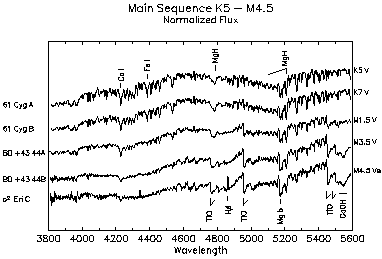


This figure uses 3.6 Å resolution spectra to take advantage of their
broader spectral coverage. In addition, the ordinate in this figure is
in terms
of "flux" instead of "rectified intensity", so that the change in the shape and
slope of the continuum can be seen as a function of spectral type. In
the K-type dwarfs, the spectral type may be estimated from the ratio of
Ca I 4227 to
Fe I 4383, in the sense that Ca I/Fe I grows toward later types. By M0, bands
due to TiO become visible in the spectrum, and these strengthen quite
dramatically toward later types; by M4.5 they dominate the spectrum. To
exclude the possibility of systematic errors in metal-weak stars, ratios of TiO
band strengths should be employed. Notice as well the development of the
MgH feature at 4780. It begins in the mid-K-type dwarfs as a pointed
tooth-like absorption feature, which then becomes progressively more
flat-bottomed
as a nearby TiO band grows in strength. A band of CaOH, a tri-atomic
molecule, makes its first appearance at about M3, and contributes to a strong
absorption feature by M4.5. Notice that H is in emission in the M4.5 star;
many M dwarfs have active chromospheres and exhibit strong flares many times
more energetic than solar flares. One of the manifestations of this is emission
in the hydrogen lines.
is in emission in the M4.5 star;
many M dwarfs have active chromospheres and exhibit strong flares many times
more energetic than solar flares. One of the manifestations of this is emission
in the hydrogen lines.

|